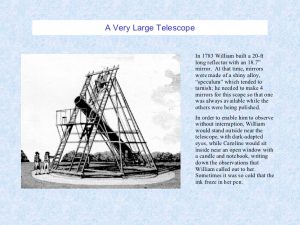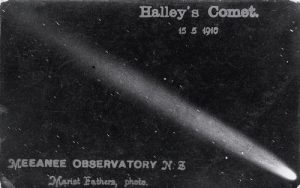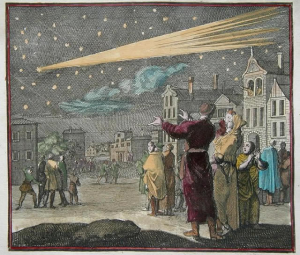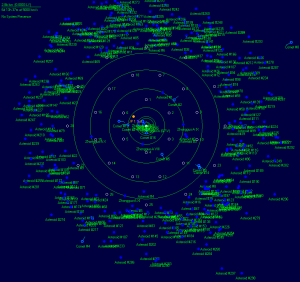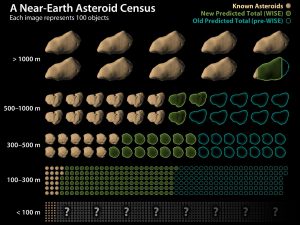Comets and Asteroids
By Hayden Gratias, Kaelyn Welch, Hayley Genaille
We will be discussing a variety of different topics related to comets and asteroids, such as the differences between the two and their connection to the Nebular Theory and the Nice Model, the discoveries of asteroids and comets, and how we classify them. Many individuals think that comets are just frozen chunks of ice and asteroids are large rocks both floating through space aimlessly. By looking into scientific resources we can research how asteroids and comets came into existence via the Nebular Theory, which hypothesizes that after the planets were created the solar winds blew away all extra particles and gas leaving behind larger planetesimals (comets and asteroids). The Nice Model hypothesizes that the solar system evolved and the orbital instability flung the smaller bodies out of Neptunes original orbit, scattering them. As we continue we will be looking more in depth at the Nebular Theory and Nice Model explanations of the creation of our solar system and how this relates to the formation of comets and asteroids. This study aims to answer the question: how did the development of the Nebular Theory and the Nice Model change our understanding of comets and asteroids?
What Are Comets?
Each comet has a tiny frozen part, called a nucleus, which is no larger than a few kilometers across. The nucleus contains icy chunks, frozen gases with bits of embedded dust.1 A comet warms up as it nears the Sun and develops a coma (Figure 1). Due to solar radiation the comet's ice changes to gas so the coma gets larger. The pressure of sunlight and solar wind can blow the coma dust and gas away from the sun, sometimes forming a long, bright tail. Comets actually have two tails - a dust tail and an ion (gas) tail.1 When moving away from the Sun at the outer edges of the solar system, the nucleus replenishes its ice by accumulating the material in the colder surroundings. Since the accumulation is slower than the loss during the active stage, gradually the comet becomes something more closely resembling an asteroid.2
Comets are suspected to be remnants of planet formation in the Solar System about 4.6 billion years ago according to the Nebular Theory.13 Comets may be an important part of the recipe for making planets. Some comets may have crashed into forming planets, adding to their water and rock, while other comets escaped to establish their own orbits around the sun. Some believe that cometary material may have brought water to Earth through impacts.3
Classification of Comets
Comets are thought to come from 3 places in the Solar System:
The Oort Cloud
A region almost a light year from the Sun. The Oort Cloud is at the edges of the Sun's gravitational influence (about 50,000 to 200,000 AU) and divided into two regions: the inner, disc-like Hills cloud, and the outer spherical cloud, both composed of icy bodies (Figure 2). Oort Cloud comets have very long orbital periods, spanning several million years, and are known as long period comets.4 They are directed towards the Sun from the Oort cloud by gravitational perturbations caused by passing stars and the galactic tide. An example is Comet Kohoutek, whose orbital period is 75,000 years.5
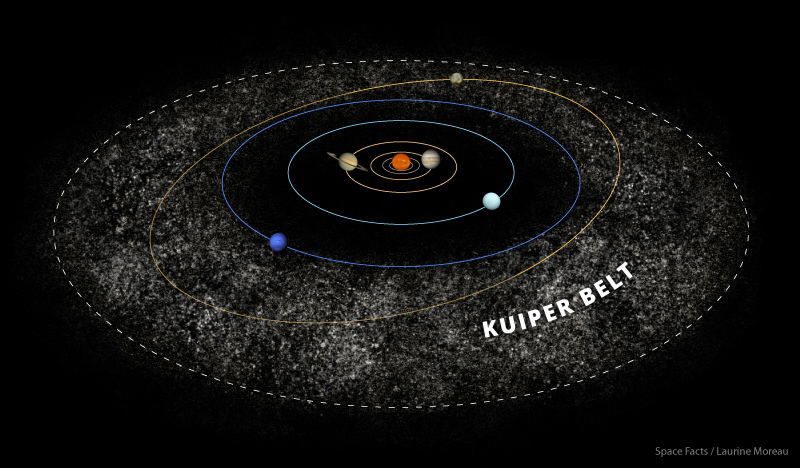
Figure 3: The Kuiper Belt
Jupiter
There are other comets from the Kuiper Belt or Oort Cloud that are corralled by Jupiter’s massive gravity into its planetary family. These comets develop very short solar orbits (from three to 20 years). The European Space Agency’s Rosetta probe, for example, targeted 67P/Churyumov-Gerasimenko to perform a detailed study of the comet (Figure 4). It currently travels in 6.57-year orbit beyond Jupiter's orbit to a point between the orbits of Earth and Mars.5 The Rosetta space probe was built by the European Space Agency and launched on 2 March 2004.5 During its journey to the comet, the spacecraft flew by Mars and the asteroids 21 Lutetia and 2867 Šteins.5

Figure 2: The Oort Cloud lies on a different plane than the planets.
The Kuiper Belt
A region beyond the orbit of the planet Neptune (Figure 3). It is a disk composed mainly of icy bodies that stretches beyond Neptune's orbit (around 30 AU from the Sun on average). Kuiper Belt comets tend to have short orbital periods, usually around 200 years, and are therefore also known as short period comets.4 They have predictable orbits and orbits, staying in the ecliptic plane and moving in the same direction as the planets. An example is Comet Halley, whose orbital period is 76 years.4
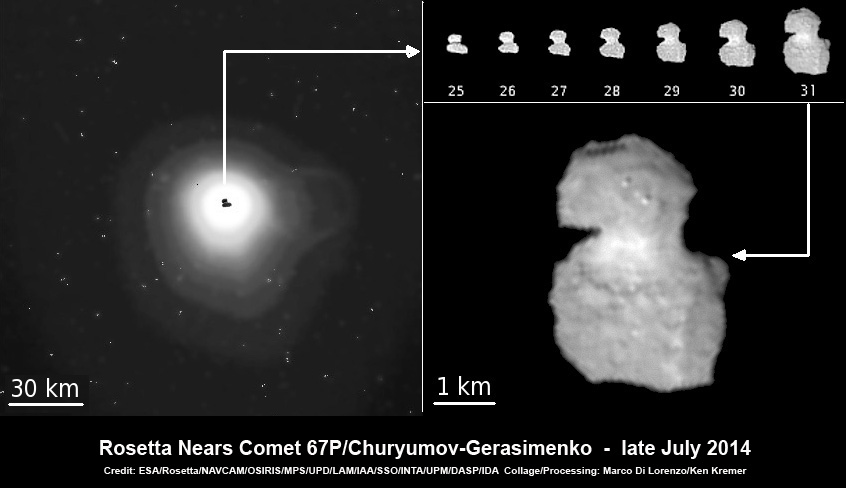
Figure 4: Comet 67P in Jupiter's orbit taken from the Rosetta Spacecraft.
In addition to these general locations within the solar system, the orientation of comets' orbits are often more randomly inclined than the orbits of the planets, which are all roughly in the same plane. The orbits of planets line up primarily on one plane. Comets arrive in the inner solar system from "above" or "below" the plane of the planets and they travel very far from the Sun. Sometimes, there is a stirring in the Oort Cloud, possibly from the gravity of nearby stars or dark matter bodies that pass through the cloud. That stirring can cause a comet to head from the Oort Cloud into the inner solar system.3
Location(s) of Comets in the Solar System
Comets are tricky objects for spacecraft to get near. Most swoop into the inner solar system on unpredictable orbits, burn brightly but briefly as they pass near the Sun and then head off again into the darkness of deep space. Past missions have either had to fly past comets at speed or crash into them in the hope that the material spewed out would reveal clues about their interiors.27
Observers used what they knew about math to begin tracking comet orbits based on their position against the stars. As technologies were developed, scientists could begin observing in a new way to discover the makeup of these icy bodies.3 For example, Rosetta was able to track the life of a comet as it arced toward the Sun in 2013.
Comet Discoveries
Over one thousand comets have been discovered to date using the Solar and Heliospheric Observatory spacecraft. The SOHO spacecraft, a joint effort between NASA and the European Space Agency, has accounted for approximately one-half of all comet discoveries with computed orbits in the history of astronomy.21
Gottfried Kirch, a German astronomer, was the first person to discover a comet by telescope; it was named the Great Comet of 1680 (Figure 5).6
The first photographic discovery of a comet was made by Edward Emerson Barnard.6
The most successful observational comet discoverer of all time was Jean-Louis Pons, who claimed to have discovered thirty-seven; the second most prolific was William Robert Brooks (Figure 7).6
What Are Asteroids?
Asteroids are small, irregularly shaped, rocky celestial bodies in space. They mainly consist of solid material, such as metals and rocks, and they are inactive. They have irregular shapes as a result of the low mass of the body, which does not generate enough gravitational pull to acquire hydrostatic equilibrium before they harden. There are millions of Asteroids in space and the majority of the observed and known asteroids reside in orbits around the sun. Asteroid orbits have low eccentricity, meaning the distance between the Sun and the asteroid does not vary much. Orbital periods of the asteroids range from tens to hundreds of years.7
Astronomers think that asteroids are the remainders of planetesimals, early pieces of the solar system, that formed between Mars and Jupiter. Some of the planetesimals began to form into planets, but were smashed apart by Jupiter's immense gravity, and others did not begin to form planets.8
Hydrostatic Equilibrium: when a fluid is at rest, or when the flow velocity at each point is constant over time. This occurs when external forces are balanced by a pressure gradient force. For instance, the pressure-gradient force prevents gravity from collapsing Earth's atmosphere into a thin, dense shell, whereas gravity prevents the pressure gradient force from diffusing the atmosphere into space.7
Classification of Asteroids
The classification of asteroids into specific groups is done according to the spectra and albedo.
An albedo of zero demonstrates a perfectly opaque object that is completely black while a measurement of one indicates a perfectly white surface. By examining the spectra of light reflected from these objects, we can classify asteroids as follows:
C - About 75% of all known asteroids fall into this category. The composition is carbon, iron, and some other compounds which make it similar to stony type meteors. The albedo of this type is between 0.03 – 0.1 which indicates that this type of asteroid is extremely dark.9
S - Twice as bright as C.8 Includes about 17% of the known asteroids in the solar system. Its surface is composed of nickel-iron with iron-silicates, and magnesium-silicates. The albedo of this type is lighter, at around 0.1 – 0.22.9
M - Similar to iron meteorites (S-type).8 Includes the remaining percentage of known asteroids in the solar system. It is usually composed of pure nickel-iron with an albedo of 0.1-0.18.9
P and D - Low brightness, reddish
- Primitive, essentially unchanged pieces of the early solar system
- Smashed remnants of differentiated pieces of the solar system8
The two most widely used systems are the Tholen classification system and the SMASS classification system.
Here is a link that describes each system: https://broom02.revolvy.com/topic/Tholen%20classification&item_type=topic
Spectra is used scientifically in optics to describe the rainbow of colors in visible light after passing through a prism.9
Albedo is a measure for reflectance or optical brightness of a surface. It is dimensionless and measured on a scale from zero to one.9
Location(s) of Asteroids in the Solar System
Main belt asteroids
The majority of asteroids in the solar system are between the planets of Mars and Jupiter. It is estimated that over one million asteroids in the belt are larger than one kilometer while millions more exist that are much smaller.9
Trojans
Asteroids that are located in specific areas of Jupiter’s orbit. Although few have been discovered, it is estimated that millions could be in these locations around Jupiter’s orbit. The Trojan asteroids share Jupiter's orbital path, but stay 60 degrees ahead or behind Jupiter.9 These asteroids occupy a stable Lagrangian point in a planet’s orbit around the Sun. These points are where a small body can be held, by gravitational forces, at one vertex of an equilateral triangle whose other vertices are occupied by the massive bodies of Jupiter and the Sun, which is why the asteroids stay 60 degrees away (Figure 10).29
Near-Earth asteroids
These asteroids have orbits which approach the Earth and are outside the main asteroid belt. About 7,000 asteroids have been discovered or are known and between 500 and 1,000 of these asteroids have diameters over a kilometer.9 Near-Earth Asteroids pose the greatest threat to Earth. Now there are a number of telescopes geared towards finding any asteroids that cross the Earth's orbit which could cause impact hazard (Figure 9).9
Here is a link to NASA’s website describing near-Earth asteroids: https://www.nasa.gov/feature/new-report-assesses-status-of-detecting-near-earth-asteroids
First Discovery of an Asteroid
The first asteroid to be discovered, Ceres, was found in 1801 by Giuseppe Piazzi, and was originally considered to be a new planet. It is 933 km long which puts it as the largest asteroid to be discovered (Figure 11).10
The Story:
The Titius-Bode law is an empirical rule giving the approximate distances of planets from the Sun. It was first announced in 1766 by the German astronomer Johann Daniel Titius but was popularized only from 1772 by his countryman Johann Elert Bode.30 The law is a numerical scheme that gives the approximate distance
from the sun of the seven inner planets but fails for Neptune and Pluto.10 It also suggested there should be a planet between Mars and Jupiter. By the end of the 18th century, a group of astronomers had banded together to use the observatory at Lilienthal, Germany, owned by Johann Hieronymous Schröter, to hunt down this missing planet.10 They called themselves, appropriately, the 'Celestial Police'. Despite their efforts, they were beaten by Giuseppe Piazzi, who discovered what he believed to be the missing planet on New Year's Day, 1801, from the Palermo Observatory.10 The new body was named Ceres but subsequent observations swiftly established that it could not be classed a major planet as its diameter is just 940 kilometres.10
Between 1801 and 1808, astronomers tracked down a further three minor planets within this region of space: Pallas, Juno and Vesta, each smaller than Ceres.10 It became obvious that there was no single large planet out there. A fifth asteroid, Astraea, was discovered in 1845, and interest in the asteroids as a new 'class' of celestial object began to build. In fact, since that time new asteroids have been discovered almost every year.
It soon became obvious that a 'belt' of asteroids existed between Mars and Jupiter. This collection of space debris was the 'missing planet' that had almost certainly prevented from forming by the large gravitational field of adjacent Jupiter.10
Differences between Comets and Asteroids
Both comets and asteroids were formed during the earliest history of the solar system.12 But there are many different ways to decipher between these two objects. The main difference between comets and asteroids are their compositions.11
Asteroids
- Made up of rocky material.11
- A few centimeters to 900km in size.11
- Tend to have shorter, more circular orbits and seem to group in belts.12
- More asteroids are known to man than comets.11
- Have no coma and usually no tail (some do have tails, like asteroid P/2010 A2 and like 3200 Phaethon, the source of Germinid meteor shower.12
- Since asteroids have much closer orbits, they are easily discovered and can be found anywhere.11
- Formed between the orbits of Jupiter and Mars, and reside in the asteroid belt between these two planets.11
- Formed much closer to the Sun, where it was too warm for ices to remain solid, which is why they typically remain more solid and self-contained near the Sun.11
- Have low eccentricity elliptical orbits.11
Comets
- Made of ice, dust, and hydrocarbon with a rocky structure- contains large amounts of frozen gases (water, ice, carbon dioxide, carbon monoxide).11
- Approximately 10km to 50km in size.11
- Because comets are very far, the distance makes it very hard to know and study them.11
- Comets were known to man first as they are observable to the naked eye.11
- Have coma and tail when near the Sun.11
- Their orbits tend to go more than 50 000 AU from the Sun.11
- Formed in the outer edges of the solar system. Reside in the Kuiper Belt and Oort Cloud.11
- Formed father from the Sun where ices do not melt. They lose material with each orbit as their ice melts and vaporizes to form a tail near the sun.12
- Have highly elongated elliptical orbits.11
Nebular Theory
The Nebular theory aims to explain how the solar system was created which states that the Sun and all the other planets started as a giant cloud of gas and dust. The cloud collapsed 4.57 billion years ago which caused pockets of dust and gas to be collected into deep regions.13 The regions continued to pull in more matter which eventually caused the matter to start rotating and heat up. Much of the material ended up in the center of the solar system in a ball while the rest of it ended up flattened into a disk that circled it.13 The ball of matter eventually formed the Sun and the circling matter formed into the protoplanetary disc.13
The planets were created from the protoplanetary disc as dust and gas came together and formed large bodies. The terrestrial planets were formed near the sun due to their high boiling points with those planets being Mercury, Venus, Earth, and Mars.13 The giant planets formed between Mars and Jupiter where it is cool enough for the icy planets to remain solid with those planets being Jupiter, Saturn, Uranus, and Neptune.13 The leftover debris that did not form planets congregated in regions including the Asteroid Belt, Kuiper Belt and Oort Cloud.13
This theory explains three observed facts about the solar system: the planets all orbit in the same direction, are all found within 6 degrees of a common plane, and all inner planets are rocky, while the planets outer ones are gaseous. 14 The belief that the planets all orbit the Sun in the same direction is explained in by the hypothesis that the planets formed in a disk of debris around the proto-Sun. 15 If they all formed in the rotating cloud, then they would all be going the same way. Evidence for the second observed fact was found through computer observations of where they are located today. The belief that inner planets are rocky, and outer planets are gaseous, is explained by the heat of the solar system. 16 The gases came together to form the protosun as the solar system’s temperature rose. The inner solar system temperatures were high up to 2000k whereas the inner solar system temperatures were as low as 50k. 16 This caused only the substances with high melting points to remain solid in the inner solar system like aluminum, iron and magnesium. The outer solar system had smaller elements like water and methane that were not vaporized over the high temperatures. 16 These elements created the giant outer planets that had more gaseous elements compared to the inner rocky planets. 16
History
The theory that the solar system was created from a nebula was offered in 1734 by Emanuel Swedenborg.13 This idea proposed by Swedenborg was developed further and published by Immanuel Kant in 1755. Kant argued that the nebula slowly rotated, resulting in a gradual collapsing and flattening from gravity leading to the formation of stars and planets. Adjustments to this theory were created after Kant including ones from Pierre-Simon Laplace and Sir David Brewster.13 Laplace gave a smaller and more detailed model that theorized that the Sun originally had an extended hot atmosphere throughout the Solar System. This “protostar cloud” cooled and contracted and as the cloud spun, it threw material from the cloud that eventually condensed and turned into planets. 13 The main issue with Laplace’s addition to the Nebular Theory was that it did not account for the momentum distribution between the Sun and the planets. A theory in the 1970s eventually emerged and has become the most widely accepted version of the nebular hypothesis called the Solar Nebular Disk Model (SDMN).13 This model was proposed in a novel by Victor Safronov and solved almost all problems of previous formation processes. 13 It explained the existence of accretion disks around young stellar discs as well as explained through, various simulations, how the material of accretion in these discs lead to the formation of a few Earth-sized bodies. The issues of the terrestrial planets origin is solved through Safronov’s additions to the model.13
Explanation of Comets and Asteroids
Solar winds are the constant outflow of gas from the Sun. The solar wind cleared leftover gas and any particles smaller than about 10m thus leaving only planetesimals. The icy leftover planetesimals of the outer solar systems are comets. The rocky leftover planetesimals of the inner solar systems are asteroids (Figure 12).17
Nice Model
The Nice model describes the evolution of the solar system through a set of theories that explain how giant planets have changed since their initial formation. The model argues that the giant planets formed in more circular orbits and a lot closer to the Sun.18 The Nice Model discusses orbits of Jupiter, Saturn, Uranus and Neptune as well as the Kuiper Belt and Oort Cloud.
History
The Nice model is named after the famous city in France where the model was developed, and is based on calculations of planets’ orbits over millions of years.19 The model is constantly being changed and looked at critically through the scientific method today. There are many variations of the Nice Model and three variations are the original Nice model, the Nice 2 model and the five planet Nice model. The original Nice model formed from a collaboration of scientists including Rodney Gomes, Hal Levison, Alessandro Morbidelli and Kleomenis Tsiganis.19 This model’s aim was to hypothesize that after the dissipation of the gas and dust of the primordial Solar System disk, the four giant planets were originally found on near-circular orbits more close together than they appear now.19 The original Nice model was faulted as the mathematics around the close proximity of planets would lead to an extremely unstable Solar System that would have ejected one of the big planets.19 The Nice 2 model builds on the first model as well as alters certain explanations from it. The Nice 2 Model addresses weaknesses of the first model mainly on timing of certain phenomena that occurred during the solar system formation.20 The most recent model argues that there was originally five larger outer planets rather than the original four which would mathematically make sense and allow still for one planet or structure to be kicked out.21
Explanation of Comets and Asteroids
The Nice model aims to explain the evolution of the solar system and certain historical events. The model aims to explain the formation of the Oort cloud and the existence of small solar system areas like the Kuiper belt.19It explains that the orbit of the giant planets that were closer together and circular changed during a phase of orbital instability. This instability caused the small bodies outside of the original orbit of Neptune to be dispersed violently. Most of the bodies were dispersed out of the Solar system but a fraction of them are found in the Kuiper belt and Oort Cloud where current comets and asteroids are found today (Figure 13).22
Comparison of the Two Theories
The two theories cannot be directly contrasted due to the theories explaining different phenomena. The Nebular Theory was focused on the creation of the planets and the Nice Model was focused on explaining where the planets are located today. One can look at these two theories and question what else we know today. There are comets and asteroids missions that have or will provide scientists with more information on comets and asteroids along with theories.
NASA has a mission planned to return with a sample of material from asteroid Bennu.23 The objectives of this mission include to: return and investigate a sample of asteroid regolith, map the properties, chemistry and mineralogy, document the texture, morphology, volatile chemistry, and to measure the orbit deviation.23 Bennu is a primitive carbon-rich asteroid and primitive asteroids’ material have not changed drastically since they were formed billions of years ago. The study of this primitive rich asteroid can give scientists an idea of the materials present at the beginning of the solar system that may have aided in the origin of life on earth (Figure 14). 24
The European Space Agency (ESA) just finished the comet mission titled “Rosetta”.25 The mission involved dropping a probe on the surface of Comet 67P and studying the origin of the comet, the relationship between the cometary and interstellar material and the implications to the origin of the solar system.25 The “Rosetta” mission involved many great accomplishments that were never previously done including orbiting a comet, landing on a comet, sniffing a comet and watching a comet change brightness and colour as it approached the sun.26 The mission discovered that comets could have aided in bringing life on Earth by seeding our planets with necessary raw materials as it saw phosphorus and organic compounds around Comet 67P. Further, it added evidence to the debate on scientists contesting whether Earth was too hot to hold on to water from its formation. 26 Some scientists argued that comets delivered bodies of water to Earth after the planet cooled but “Rosetta” showed that the Comet 67P’s measurement of water ice had much more hydrogen than in ocean water on Earth (Figure 15).27
These are two current missions that space agencies are conducting to find out more information on comets and asteroids and their implications on the solar system.
Conclusion
There are many different theories and models to explain the creation of the solar system. Each of these theories are backed up by sufficient amounts of evidence, but plenty can also be disproved by being unable to explain a variety of phenomena. According to the Nebular theory the solar system was created 4.6 billion years ago from a cloud of interstellar gas and dust. The Sun's solar winds supposedly pushed all the dust and particles away leaving behind the planetesimals. There are three observations that can help to prove this theory: planets all orbit in the same direction, they all orbit within 6 degrees of a common plane, and the inner planets are rocky but the planets on the outside are gaseous. The Nice Model on the other hand explains the locations of concentrations of planets as well as comets and asteroids within the solar system. In order to explain comets and asteroids it is theorized that giant planets that were closer together had their orbits changed due to a phase of orbital instability. This instability caused smaller bodies outside the orbit of Neptune to be pushed away violently. While most were pushed out of the solar system, some still remain in the Kuiper Belt and Oort Cloud today.
The Nebular Theory and the Nice Model try to explain how the solar system was created and how the planets became situated in their current positions. Through each process there are unanswered questions, like in all theories. Which is why it's considered a theory rather than fact. As you explored the definitions, evidence, diagrams, and explanations you may have come to your own conclusions on the origin of comets and asteroids or maybe even how the solar system was formed. Maybe you disagree with both and are an all time fan of a third theory that suits your beliefs better than these two can. Regardless, there are always discoveries being made and astounding new evidence. People dedicate their whole lives to the research that proves our solar system's origin, throughout history many individuals have paved the way for astronomy, Galileo, Kepler, and Copernicus are just a few examples. It takes hundreds of years to get one step closer to unlocking the knowledge of our solar system's existence. Without their hard work we'd be set back, taking longer to understand how everything around us came to be. That's what science is, dedication.

References
1NASA, Comets: Overview: Icy Travellers, https://solarsystem.nasa.gov/planets/comets (Accessed October 28, 2017)
2Maria Temming, Comets: What Are They? Where Do They Come From?, www.skyandtelescope.com/astronomy-resources/what-is-a-comet/, (Accessed October 28, 2017)
3NASA, A Comet’s Place In The Solar System, http://deepimpact.umd.edu/educ/mod_ExploringComets/04_ExploringComets_SolarSystem.pdf, (Accessed October 28, 2017)
4Time and Date, What Are Comets?, https://www.timeanddate.com/astronomy/comets/, (Accessed October 28, 2017)
5Rosetta, Where Do Comets Come From?, https://rosetta.jpl.nasa.gov/science/comet-primer/where-do-comets-come, (Accessed October 28, 2017)
6European Southern Observatory, Comets, https://www.eso.org/public/events/astro-evt/hale-bopp/comet-history-1/, (Accessed October 28, 2017)
7Yvonne Tang, Comets, Meteors & Asteroids, http://curious.astro.cornell.edu/our-solar-system/comets-meteors-and-asteroids, (Accessed October 29, 2017)
8Craig Freudenrich, How Asteroids Work, https://science.howstuffworks.com/dictionary/astronomy-terms/asteroid1.htm, (Accessed October 29, 2017)
9Act For Libraries, Type and Classification of Asteroids, http://www.actforlibraries.org/type-and-classification-of-asteroids/, (Accessed October 29, 2017)
10European Space Agency, Asteroids: The discovery of asteroids, www.esa.int/About_Us/Welcome_to_ESA/ESA_history/Asteroids_The_discovery_of_asteroids, (Accessed October 28, 2017)
11DifferenceBetween, Difference Between Comets and Asteroids, http://www.differencebetween.com/difference-between-asteroid-and-vs-comet/, (Accessed October 30, 2017)
12EarthSky, What’s the difference between comets and asteroids?, http://earthsky.org/space/whats-the-difference-between-comets-and-asteroids, (Accessed October 30, 2017)
13Matt Williams, How was the Solar System formed? – The Nebular Hypothesis, https://www.universetoday.com/38118/how-was-the-solar-system-formed/ (Accessed October 29, 2017).
14Chris Deziel, What is the Nebular Theory?, http://education.seattlepi.com/nebular-theory-4444.html (Accessed November 28)
15Karen Masters, What is the evidence supporting the nebula theory of Solar System formation? (Intermediate), http://curious.astro.cornell.edu/physics/159-our-solar-system/the-sun/the-solar-system/169-what-is-the-evidence-supporting-the-nebula-theory-of-solar-system-formation-intermediate (Accessed November 27, 2017)
16Las Cumbres Observatory, Planets and How they Formed, https://lco.global/spacebook/planets-and-how-they-formed/ (Accessed November 27, 2017)
17Columbia University, The solar nebula formation of the earth: origin of the atmosphere and oceans, http://www.columbia.edu/~vjd1/solar_nebula.html/ (Accessed October 29, 2017)
18L. Dones and H. Levison, The impact rate on giant planet satellites during the Late Heavy Bombardment in the Nice 2 Model, https://www.lpi.usra.edu/meetings/lpsc2013/eposter/2772.pdf (Accessed November 2, 2017)
19Wikipedia, Nice model, https://en.wikipedia.org/wiki/Nice_model (Accessed November 2, 2017)
20Wikipedia, Nice 2 Model, https://en.wikipedia.org/wiki/Nice_2_model (Accessed November 2, 2017)
21Physics World, Was a giant planet ejected from our solar system?, http://physicsworld.com/cws/article/news/2011/nov/21/was-a-giant-planet-ejected-from-oursolar-system (Accessed November 2, 2017)
22Observatoire de la Côte d’Azur, A strong prediction of the “Nice model” validated by the Rosetta mission, https://www.oca.eu/en/research-oca/103-une-prediction-forte-du-modele-denice-validee-par-la-sonde-rosetta-2 (Accessed November 2, 2017)
23Nasa, OSIRIS-Rex, https://nssdc.gsfc.nasa.gov/nmc/spacecraftDisplay.do?id=2016-055A (Accessed Novermber 14, 2017)
24Nasa, To Bennu and Back, https://science.nasa.gov/news-articles/bennu-and-back (Accessed November 28, 2017)
25Nasa, Rosetta, https://nssdc.gsfc.nasa.gov/nmc/spacecraftDisplay.do?id=2004-006A (Accessed November 14, 2017)
26Michael Greshko, https://news.nationalgeographic.com/2016/09/rosetta-crash-comet-spacecraft-esa-philae-science/ (Accessed November 28, 2017)
27Nasa, OSIRIS-Rex, https://nssdc.gsfc.nasa.gov/nmc/spacecraftDisplay.do?id=2016-055A (Accessed Novermber 14,2017)
28Nasa, Rosetta, https://nssdc.gsfc.nasa.gov/nmc/spacecraftDisplay.do?id=2004-006A (Accessed November 14, 2017)
29Encyclopedia Britannica, Trojan Asteroid, https://www.britannica.com/topic/Trojan-asteroid (Accessed November 12, 2017)
30Encyclopedia Britannica, Bode’s Law, https://www.britannica.com/science/Bodes-law (Accessed November 12, 2017)



